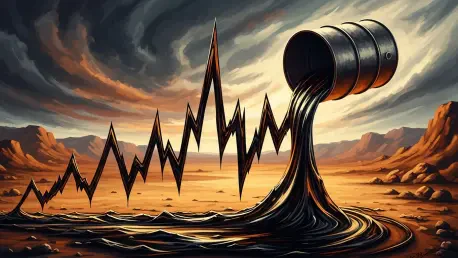Today, we’re thrilled to sit down with Christopher Hailstone, a seasoned expert in energy management, renewable energy, and electricity delivery. With his deep knowledge of utilities and grid reliability, Christopher offers unparalleled insights into the complex interplay of global energy markets and geopolitical events. In this interview, we’ll dive into the recent drop in oil prices, the impact on energy stocks, and the potential ramifications of a proposed peace plan for Ukraine and Russia. We’ll also explore how U.S. sanctions, currency fluctuations, and monetary policy are shaping the energy landscape.
Can you walk us through the reasons behind the recent drop in oil prices, particularly with Brent crude and West Texas Intermediate futures declining on Friday?
Certainly. Oil prices took a hit recently due to a combination of geopolitical developments and market dynamics. Brent crude futures for January expiry dropped by 1.29%, closing at $62.56 per barrel, while West Texas Intermediate futures for the same period fell by 1.59%, settling at $58.06. These declines follow smaller dips in the previous session, signaling a broader bearish sentiment. A lot of this stems from uncertainty in the market, driven by geopolitical proposals and economic factors like a stronger U.S. dollar, which tends to pressure commodity prices by making oil more expensive for foreign buyers.
How have these falling oil prices influenced energy stocks across the globe?
The impact on energy stocks has been quite pronounced. In Europe, the Stoxx Oil and Gas index dropped over 2.4%, reflecting widespread concern. Major players like Shell and BP in the UK saw their stock prices fall by about 1.4% each, while Norway’s Equinor declined by 2.3%. In Germany, Siemens Energy took an even bigger hit, plunging nearly 8%. Across the Atlantic, U.S. giants like Exxon Mobil and Chevron weren’t spared either, with declines of 1.1% and 0.6%, respectively. This broad sell-off mirrors the uncertainty in oil prices and suggests investors are bracing for potential volatility ahead.
What role does the proposed Ukraine peace plan play in these market movements?
The proposed peace plan, reportedly pushed by the Trump administration, has introduced a significant layer of uncertainty into the energy markets. The draft suggests Ukraine cede territories like Crimea, Luhansk, and Donetsk to Russia, alongside a commitment not to join NATO and a cap on Ukrainian military personnel at 600,000. Since energy markets are highly sensitive to geopolitical stability, especially in regions critical to oil and gas supply chains, this plan has spooked investors. Many see it as potentially favoring Russia, which could alter regional dynamics and impact energy trade routes or sanctions regimes, directly affecting oil prices and stock valuations.
How are investors interpreting the specifics of this peace proposal, especially the territorial and military stipulations?
Investors are quite wary about the territorial concessions outlined in the plan, particularly Ukraine giving up Crimea, Luhansk, and Donetsk. These regions are strategically significant, and their loss could signal a weaker Ukrainian position, potentially emboldening Russia in future negotiations or conflicts. Additionally, the limit on Ukrainian military personnel to 600,000—a reduction of about a third from current levels—raises concerns about Ukraine’s ability to defend itself, which could destabilize the region further. This uncertainty is translating into cautious, if not outright negative, sentiment in energy markets, as stability in Eastern Europe is crucial for consistent oil and gas flows.
What’s the broader expert opinion on whether this peace plan can realistically come to fruition?
There’s a fair amount of skepticism among experts about the feasibility of this plan. While dialogue between parties is always a positive step, the specifics of this proposal are seen as heavily tilted in one direction, making it a tough sell for Ukraine. For instance, some analysts have pointed out that reducing Ukraine’s military personnel by such a large margin could be a major sticking point, as it directly impacts national security. The consensus seems to be that while negotiations are welcome, the current framework might not have the balance needed to secure agreement from all sides, which keeps markets on edge.
Beyond the peace plan, what other pressures are weighing on oil prices at the moment?
There are several other factors at play. U.S. sanctions on major Russian oil producers like Rosneft and Lukoil, which took effect recently, are disrupting supply expectations and adding to market volatility. At the same time, a stronger U.S. dollar is making oil pricier for international buyers, dampening demand. Additionally, anticipation around the Federal Reserve’s upcoming interest rate decision is influencing investor behavior. Higher rates could slow economic growth and reduce oil consumption, so there’s a lot of focus on how monetary policy will unfold in the near term.
Looking ahead, what is your forecast for the energy markets given these geopolitical and economic challenges?
I think we’re in for a period of sustained volatility in the energy markets. The combination of geopolitical uncertainties, like the Ukraine peace plan, and economic pressures, such as U.S. sanctions and potential interest rate hikes, creates a complex landscape. If the peace negotiations stall or fail, we could see sharper price swings in oil as risk premiums get priced in. On the other hand, if there’s progress toward stability, we might see some relief in prices, though sanctions on Russian oil will likely keep supply concerns alive. I’d advise keeping a close eye on both diplomatic developments and central bank actions over the next few months, as they’ll be key drivers of where energy markets head next.









